About UCMP : News and events : UCMP newsletter
Paleontology and biology merge at Berkeley, 1957–present
 |
 |
 |
 |
This is the fifth and final article in a series on the history of UCMP, adapted from a more detailed and referenced paper by Jere H. Lipps: 2004. Success story — the history and development of the Museum of Paleontology at the University of California, Berkeley. Proceedings of the California Academy of Sciences 55 (Suppl. I):209-243. 22 figs.
|
 |
 |
 |
 |
 |
 |
 |
 |
 |
 |
 |
 |
For over 100 years, paleontology was steeped in description and stratigraphy, dealing with the history of biotas. Berkeley originally followed that path, but as the decades unfolded, an increased emphasis on biology developed. In the 1950s, the Department of Paleontology hired its first paleobiologist with the appointment of Zach Arnold, a protozoologist working on foraminifera. As faculty retired, passed away, or moved to other places, additional experts were hired in functional morphology, paleoceanography, paleoecology, and evolutionary paleobiology.
 |
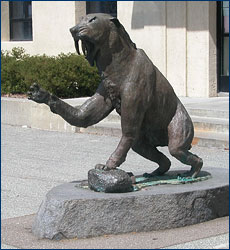
The saber-toothed cat sculpture, done by Victor J. "Trader Vic" Bergeron and donated to UCMP, is the only remaining indication that paleontology ever occupied the former Earth Sciences Building, now known as McCone Hall.
|
UCMP and the Department were closely tied together as they moved into the new Earth Sciences Building in 1961. This move provided adequate housing for the collections, and under the leadership of Director William Berry (1975–1988), the collections began to be computerized. Berry also established a focus on outreach, initiating the Friends of Fossils, the Young People's Lecture Series, an enormously successful Open House, and an annual paleontology conference for the entire University of California. UCMP developed the "Explorations of Ancient Life" exhibit at the Museums at Blackhawk in Danville in 1991 and acquired the famous Blackhawk fossil quarry (right, second from top).
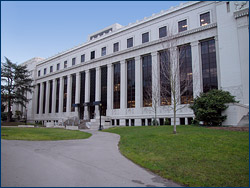
The renovated Valley Life Sciences Building houses UCMP on the west side of the lower floor (windows just below the columns). UCMP moved there in 1995 after 34 years in the Earth Sciences Building, now McCone Hall.
|
 |
By 1989, the UCB's biological science departments had been reorganized, bringing paleontology into the new Department of Integrative Biology (IB), and UCMP into the newly renovated Life Sciences Building in 1995. This move took several years, and during this same period, the University budget was decreased about 20%, resulting in early retirements, layoffs and financial cuts in most programs, including those of UCMP and IB. The early 1990s were difficult years. Faculty and students found themselves in new relationships to their colleagues and in unfamiliar quarters; the collections were closed for several years while being moved; and budget restrictions affected everyone. Nevertheless, UCMP became an independent research organization closely affiliated with IB as many of its faculty curators and most of its graduate students came from that department. In 1994, UCMP joined the Museum of Vertebrate Zoology, the University and Jepson Herbaria, the Essig Museum of Entomology, and the University Botanical Garden to form the Berkeley Natural History Museums. Today, BNHM is an effective consortium sponsoring lectures, workshops and research projects, and facilitating student interactions.
 |
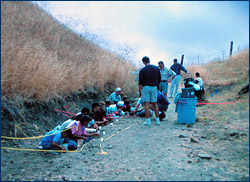
Families at the Blackhawk Fossil Dig, a community outreach activity at the Blackhawk Quarry, held during the 1990s.
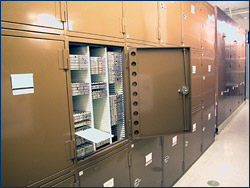
The Museum houses millions of fossil and modern organisms from vertebrates to microfossils (shown here). Some are used for teaching and all are used for research by faculty, graduate students, and visiting scientists.
|
UCMP outreach increased, with fossil displays at the Petrified Forest National Park, UC Davis, the California Academy of Sciences, the campus Doe Library, and the Big Fresno County Fair, and also included a popular community dig at the Blackhawk fossil quarry. The "Trail through Time," a collaborative effort of UCMP and the Mt. Diablo State Park, was established, along with an annual Trek through Time that led hikers through the 150 million years of rocks exposed on the flanks of Mt. Diablo.
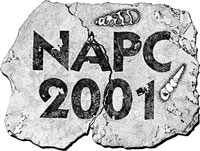
The logo for the 2001 North American Paleontology Convention, hosted by UCMP.
|
 |
UCMP also promoted international activities. It sponsored several major scientific meetings during the 1990s: American Malacological Union 1991, Forams 1994, and the North American Paleontology Convention 2001. New collaborations with the Paleontological Institute of the Russian Academy of Sciences started in 1992 with an exchange of scientists and students. UCMP's publication, PaleoBios, was started in 1963, enhanced in 1992, and still publishes paleontological papers distributed worldwide.
Today UCMP serves a wide variety of people. Each year, the campus community, including hundreds of undergraduates, use the collections, exhibits and facilities in research and course work. UCMP reaches a broader audience through its visitor programs, loans, Cal Day exhibits, school tours, lecture series, visitor programs, and its award-winning web sites that together serve more than five million page accesses each month. The paleontology program, centered on UCMP, was judged number one in America by U.S. News and World Report through the middle 1990s.
Because the Museum maintains large collections, has a significant endowment, and supports so many diverse and important activities for so many people, it is a permanent part of the University of California at Berkeley, as it has been for many decades. As paleontology in general expands into environmental analyses, conservation biology, astrobiology, biometrics, biodiversity, and other emerging new fields, UCMP's preeminence in the field should continue unabated for many more decades.
The complete text of Jere Lipps' paper on the history of UCMP can be read online in The history of UCMP section.




